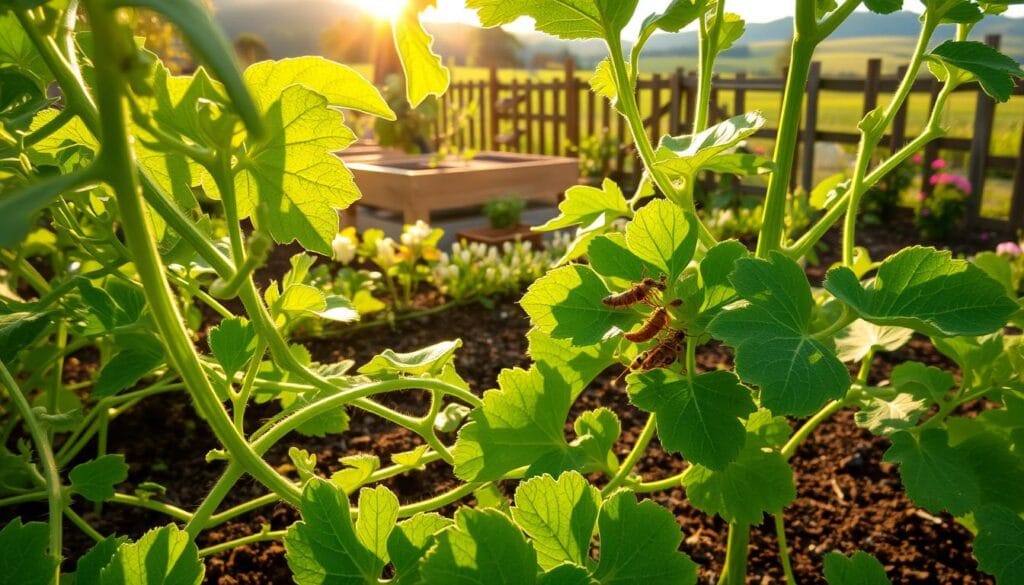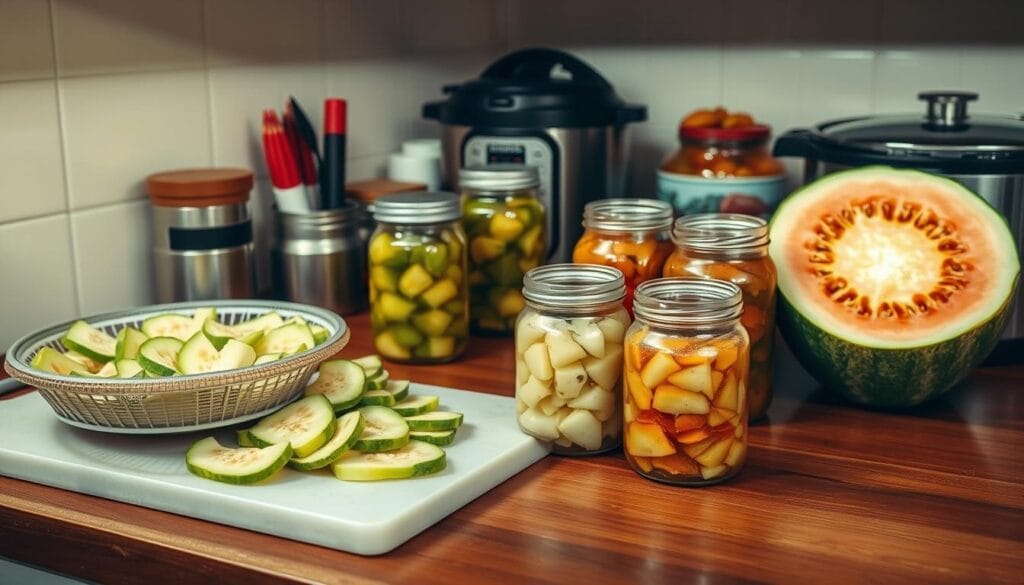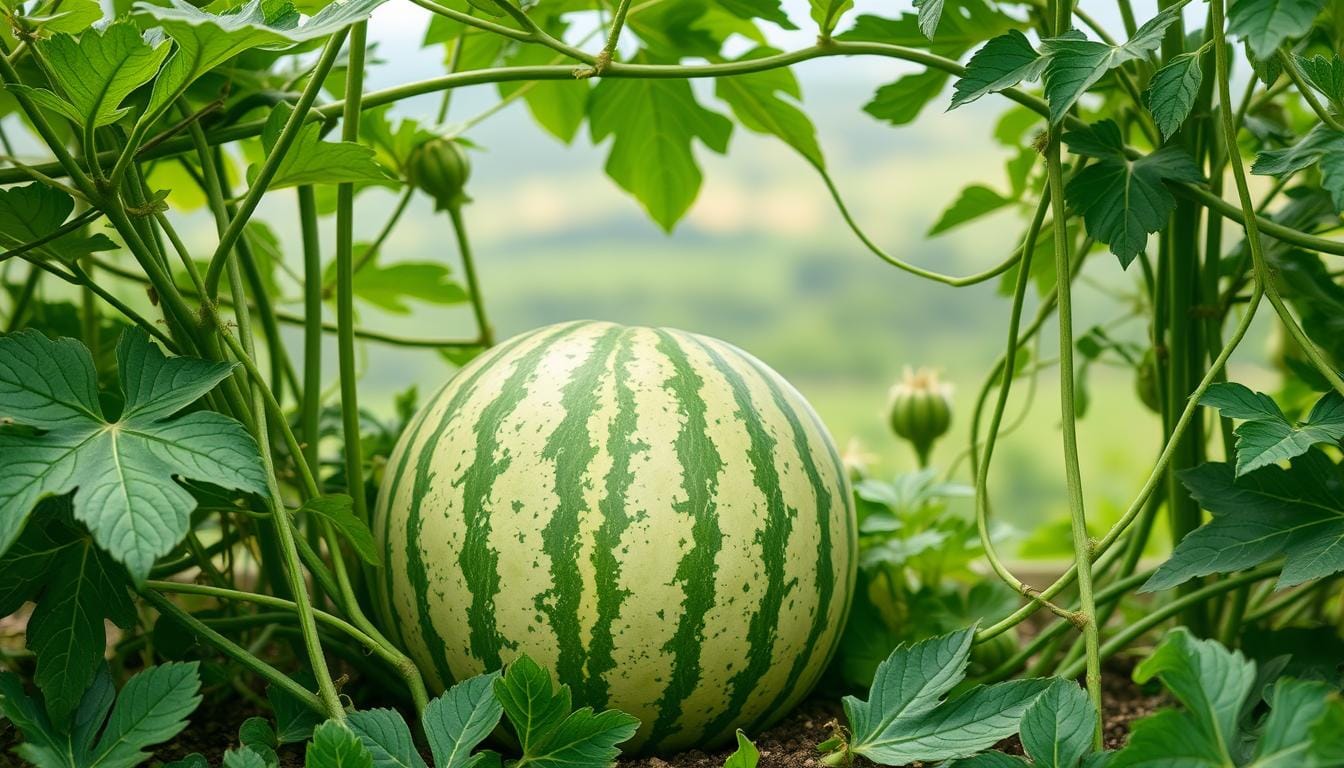Xigua: How to Grow Your Own at Home in 6 Steps
Table of Contents
Summer memories come alive when I first tasted a homegrown watermelon. The crisp, sweet xigua was unlike anything from the store. Growing your own watermelon is more than a gardening project. It’s a journey of patience, care, and delicious rewards.
Watermelons have captured the hearts of gardeners around the world. With over 1,000 varieties, there’s a lot to explore. Xigua, a special melon in Chinese cuisine, is a unique chance for home gardeners. Whether you’re experienced or new, growing xigua can turn your backyard into a fruit paradise.
This guide will show you six key steps to grow your own watermelon. From picking the right variety to harvesting your juicy reward. Get ready for a gardening adventure that promises sweet success!
Key Takeaways
- Xigua watermelons offer a unique and rewarding home gardening experience
- Growing your own fruit provides unmatched freshness and flavor
- Success depends on understanding specific growing conditions
- Patience is crucial in watermelon cultivation
- Home gardening connects you directly with your food source
Understanding Xigua Watermelon Varieties
Xigua watermelons are a great summer choice for gardeners. They offer hydrating foods and refreshing snacks. With over 50 varieties, picking the right one can be fun.
Watermelons have a long history. They were first grown for their water to help people during dry times. Now, gardeners can pick from many types that grow well in different places.
Popular Xigua Cultivars for Home Growing
- Picnic watermelons: 16-45 pounds, 85-day maturation
- Icebox watermelons: 5-15 pounds, 75-day maturation
- Yellow/orange fleshed varieties: 75-day maturation
Differences Between Traditional and Seedless Varieties
There are two main types of watermelons: seeded and seedless. Seedless ones are 10-20 pounds and take about 85 days to grow. They’re easy to eat.
Climate Requirements for Different Varieties
| Variety Type | Ideal Temperature | Sun Exposure |
|---|---|---|
| Picnic Watermelons | 75-85°F | Full Sun |
| Icebox Watermelons | 70-80°F | Direct Sunlight |
| Seedless Varieties | 80-90°F | Intense Sunlight |
“Choose a watermelon variety that matches your local climate and garden space for the best growing results.”
Watermelons are 92% water. They’re perfect for gardeners looking for hydrating foods and refreshing summer snacks.
Essential Growing Conditions for Xigua Success
Growing xigua watermelons needs careful attention to specific conditions. These fruits thrive in gardens with the right environment. Knowing the key factors for healthy growth is crucial.
The climate is key for growing xigua. They need certain temperatures and humidity to grow well. The best conditions include:
- Consistent temperatures between 70-85°F
- Full sun exposure (6-8 hours daily)
- Moderate humidity levels
- Protection from strong winds
Xigua watermelons love warm, well-draining places. They come from tropical and subtropical areas. Your garden’s climate greatly affects their growth and fruit.
| Growing Condition | Optimal Range | Impact on Plant |
|---|---|---|
| Temperature | 70-85°F | Promotes robust growth |
| Sunlight | 6-8 hours direct sun | Supports photosynthesis |
| Humidity | 50-70% | Prevents plant stress |
“The secret to great xigua is creating a nurturing environment that mimics their natural habitat.” – Gardening Expert
Pro tip: Watch your garden’s microclimate closely. Small changes can greatly help your xigua watermelon’s health and fruit.
Soil Preparation and Planting Requirements
Growing vitamin c-rich foods like xigua watermelon needs careful soil prep and smart planting. Success begins with knowing the basics for a great growing spot.
Optimal Soil pH and Composition
The best soil for xigua is slightly acidic, with a pH of 6.0 to 6.5. This pH helps plants absorb nutrients well and grow strong. To get your soil ready:
- Check your soil’s pH level
- Add lime 2-3 months before planting
- Mix in amendments in the top 15-20 cm of soil
Fertilization Strategy
Managing nutrients is key for growing vitamin c-rich foods like xigua. Here’s what to do for fertilizing:
| Nutrient | Recommended Amount | Application Timing |
|---|---|---|
| Nitrogen (N) | 68 kg per hectare | Half before planting, half 4-6 weeks after seeding |
| Phosphorus (P2O5) | 68 kg per hectare | Pre-planting |
| Potassium (K2O) | 68 kg per hectare | Pre-planting |
Spacing and Planting Depth
Right spacing lets xigua plants grow well and get nutrients. Make fertilizer bands 60-100 cm wide in rows before planting. Plant seeds at the same depth for even germination.
“Good soil preparation is the foundation of a successful xigua harvest.” – Agricultural Expert
By sticking to these tips, you’ll grow healthy and tasty xigua watermelons in your garden.
Watering and Irrigation Techniques
Growing xigua watermelons needs a smart watering plan. These plants need steady moisture from start to finish. Your plants will thank you with tasty, refreshing snacks.
Water is key for xigua growth. Young seedlings need gentle, often watering to grow strong roots. As they grow, their water needs change a lot.
“Water is the lifeblood of watermelon cultivation” – Agricultural Expert
- Seedling stage: Water lightly but frequently
- Vegetative growth: Increase water volume
- Fruit development: Critical watering period
- Pre-harvest: Reduce watering to concentrate fruit sweetness
Drip irrigation is best for xigua watermelons. It sends water straight to the roots, saving water and preventing diseases. Consistent moisture stops fruit cracking and helps plants grow well.
Try to give 1-2 inches of water each week. Water deeply but not too often to help roots grow deep. Watering in the morning helps leaves dry, which fights off fungi.
Pro Tip: Use mulch to keep soil moist and control ground temperature
Look out for signs of water stress. Wilting leaves or yellowing mean your plants need water fast. Good hydration leads to juicy, tasty watermelons for summer snacks.
Supporting Vine Growth and Development
Growing xigua watermelons needs careful support for vine growth. Your vines can thrive with the right techniques. These help with fruit production and plant health.
Understanding how to care for your watermelon from seedling to harvest is key. Let’s look at important strategies for supporting your vines.
Trellising Methods for Optimal Growth
Trellising is crucial for your watermelon vines. It helps them grow well in small garden spaces. Here are some trellising options:
- A-frame trellis for vertical growth
- Sturdy wire mesh supports
- Wooden frame structures
- Robust metal garden frames
Pruning Techniques for Healthy Vines
Proper pruning directs your xigua plant’s energy to fruit production. Strategic trimming improves air circulation and lowers disease risk.
- Remove dead or yellowing leaves
- Cut back excess lateral shoots
- Maintain 2-3 main vine branches
- Trim areas with dense foliage
Pollination Support Strategies
Watermelon plants need good pollination to produce fruit. Attract pollinators with companion flowers and a bee-friendly garden.
“The secret to a bountiful xigua harvest lies in supporting your plant’s natural growth cycles.” – Garden Experts
If natural pollination is not enough, manually transfer pollen. Use a small brush between male and female flowers. This ensures your fruit grows well.
Managing Common Pests and Diseases

Growing summer produce like xigua melons has its challenges. Pests and diseases can harm your crop. Knowing about these threats helps protect your harvest.
- Lay up to 250 eggs on leaf undersides
- Complete their life cycle in 6-8 weeks
- Produce one generation per year in cooler regions
It’s important to watch for damage thresholds in watermelon crops. Experts say to monitor pest populations closely:
| Crop Type | Pest Threshold |
|---|---|
| Watermelon | 1 adult per plant |
| Summer Squash | 1 adult per 2-3 plants |
Integrated Pest Management (IPM) is the best way to protect your xigua melons. Here are some effective strategies:
- Check plants in June, a key time for pests
- Use trap cropping to control squash bugs
- Try biological controls like parasitic flies
- Apply targeted chemical treatments for good coverage
“Prevention is always better than cure in crop management.” – Agricultural Research Experts
Choosing disease-resistant cultivars can lessen treatment needs. By picking strong varieties and managing proactively, you’ll keep your summer produce healthy.
Harvesting Your Xigua
Growing xigua watermelons needs careful attention to harvesting. Knowing when and how to pick them ensures you get the tastiest and healthiest snacks from your garden.
Identifying Peak Ripeness
To find the perfect time to harvest your xigua, look for these signs:
- Check the ground spot where the watermelon rests – it should turn from white to yellow
- Listen for a deep, hollow sound when tapping the watermelon
- Observe the vine tendril nearest the fruit – it should be brown and dried
- Examine the watermelon’s color – deep green with a dull surface indicates ripeness
Precise Harvesting Techniques
When you’re ready to pick your xigua, use sharp pruning shears. Cut the fruit from the vine, leaving a short stem to prevent disease. Don’t pull or twist, as this can harm the plant or other fruits.
Post-Harvest Care
After picking, handle your xigua with care to keep it fresh. Gently clean it with a soft cloth. Store it at room temperature if you plan to eat it soon, or refrigerate it for longer freshness.
| Ripeness Indicator | What to Look For |
|---|---|
| Ground Spot Color | Yellow, not white |
| Sound Test | Deep, hollow resonance |
| Vine Tendril | Brown and dried |
| Surface Appearance | Dull, deep green |
“The secret to great watermelons is knowing exactly when to harvest.” – Garden Experts
Storage and Preservation Methods

Preserving your home-grown xigua lets you enjoy its health benefits year-round. You can use several storage methods to keep your watermelon tasty and nutritious. This way, you can enjoy it as delicious preserved products.
- Freezing whole or cubed pieces
- Creating watermelon juice
- Dehydrating watermelon slices
- Pickling watermelon rind
Freezing is a great way to keep your xigua fresh. Cut it into cubes or chunks and store them in airtight containers. These frozen pieces are perfect for smoothies or as a cool summer snack.
| Preservation Method | Estimated Storage Duration |
|---|---|
| Freezing | Up to 6 months |
| Dehydrating | 6-12 months |
| Pickling | 2-3 months |
Dehydrating turns xigua into light, concentrated snacks. You can buy simple dehydrating machines for about $35. They help make unique watermelon chips. It takes 8-12 hours to dry them, making a nutritious snack that lasts a long time.
“Preservation is about extending the joy of harvest and minimizing food waste.” – Gardening Expert
Always label your preserved xigua with the date. Use the right storage containers to keep it fresh and prevent contamination.
Nutritional Benefits of Home-Grown Xigua
Growing your own xigua is more than just a hobby. It’s a way to enjoy some of the freshest snacks around. This amazing fruit is full of nutrients, making it perfect for healthy summer snacks.
Xigua watermelon is packed with vitamins and minerals. Let’s look at what makes it so nutritious:
- High water content (92%) for superior hydration
- Rich in Vitamin A for eye and immune health
- Excellent source of Vitamin C for skin and immune support
- Contains Vitamin B6 for metabolic functions
Home-grown xigua is different from store-bought ones. Its freshness and nutrients are unmatched. Growing your own means you control the growing conditions, ensuring the best taste and nutrition.
“Homegrown produce is nature’s most delicious multivitamin” – Local Gardening Enthusiast
Eating xigua as a snack can boost your health. It’s low in calories but full of nutrients. This makes it a great choice for those looking for tasty, healthy snacks.
Tips for Year-Round Growing Success
Growing xigua watermelon all year needs smart planning and new ways to grow. Summer produce has a short growing time. But, gardeners can grow watermelon longer with the right methods.
To grow xigua all year, know the seasonal challenges and use smart strategies. Many types of watermelon can grow fruit in 100 days. So, planning carefully is key for a steady harvest.
Seasonal Planning Strategies
Plan your watermelon garden with the seasons in mind:
- January: Order seeds and plan your garden
- May: Start planting outside in warm places
- Late summer: Get ready for a fall crop
- Winter: Try growing indoors
Succession Planting Techniques
Plant your xigua at the right times to get more fruit. Plant every 2-3 weeks for a steady harvest. This method helps:
- Spread out when the fruit is ready
- Avoid too much fruit at once
- Keep a steady supply of summer produce
Indoor Growing Options
Grow watermelon indoors with new methods:
- Use grow lights for light
- Pick small xigua varieties
- Keep the temperature between 70-85°F
- Try hydroponics for better growth
“With the right techniques, you can enjoy homegrown watermelons year-round!” – Gardening Expert
Use these tips to turn growing xigua into a year-round hobby. It will become a fun and ongoing project.
Conclusion
Growing your own Xigua watermelon can change your home gardening. You’ve learned how to pick the right variety and grow it well. This guide shows you how to grow your melon at home.
Understanding soil, watering, and solving problems is key. Each step needs care and patience. By following these tips, your melons will be sweeter than store-bought ones.
Home gardening keeps getting better with time. This guide is a good start, but your own experiences will make you better. Start small, try different melons, and don’t worry about mistakes. Soon, you’ll enjoy your own Xigua watermelons.
Growing your own fruits like Xigua is rewarding and teaches you a lot. Enjoy the learning and look forward to the fruits of your labor.
FAQ
What is Xigua, and how is it different from regular watermelon?
Xigua is a Chinese watermelon that’s similar to regular watermelons. It’s often bigger and has a unique taste. It also might have more water inside. Growing Xigua at home is exciting, but it needs special care.
How long does it take to grow Xigua from seed to harvest?
Growing Xigua takes 70 to 100 days, depending on the variety and growing conditions. Temperature, soil, and care affect the time. Watch your plants for signs of ripeness, like a yellow spot on the bottom.
Can I grow Xigua in containers?
Yes, you can grow Xigua in containers. Use a big pot (at least 5 gallons) with good drainage. Choose varieties that grow well in containers. Make sure the container gets full sun and support the vines as they grow.
What are the most common challenges when growing Xigua?
Common challenges include pests, powdery mildew, pollination, and keeping the soil moist. Good soil, crop rotation, and regular checks can help solve these problems.
How much water do Xigua plants need?
Xigua plants need about 1-2 inches of water a week. Water deeply but less often to promote deep roots. When the fruit grows, water more but avoid wetting the leaves to prevent disease.
Are seedless Xigua varieties easier to grow?
Seedless Xigua varieties are harder to grow because they need special pollination. They require a seeded variety nearby for fruit. They’re more convenient but need more gardening skill.
What are the nutritional benefits of Xigua?
Xigua is very nutritious, full of vitamin C, lycopene, and potassium. It’s mostly water, making it a great summer snack. It’s low in calories and full of antioxidants, good for health and hydration.
Can I save seeds from my Xigua for next season?
You can save seeds from open-pollinated Xigua varieties. But hybrid varieties won’t grow true to type. Choose a ripe fruit, clean and dry the seeds, and store them in a cool, dark place.
What’s the best time of year to plant Xigua?
Plant Xigua after the last frost when the soil is at least 70°F (21°C). This is usually late spring to early summer. Make sure you have a long, warm season for fruit to grow.
How can I tell when my Xigua is ripe?
Look for a yellow spot on the bottom, a dull sound when tapped, and a dried tendril near the stem. The skin should be deep and matte, not shiny.
Source Links
- 4 Lessons from My Visit to ByteDance (Tech Strategy – Daily Article) – Jeffrey Towson 陶迅 – https://jefftowson.com/membership_content/4-lessons-from-my-visit-to-bytedance-tiktok-headquarters-tech-strategy-daily-article/

